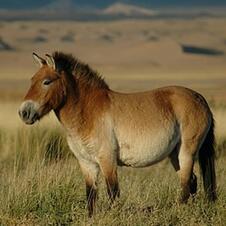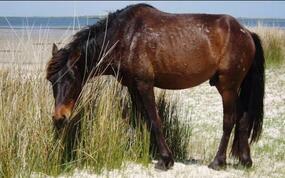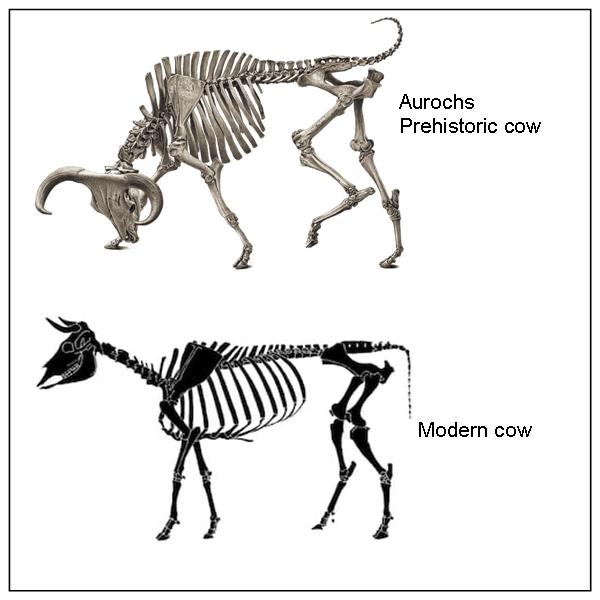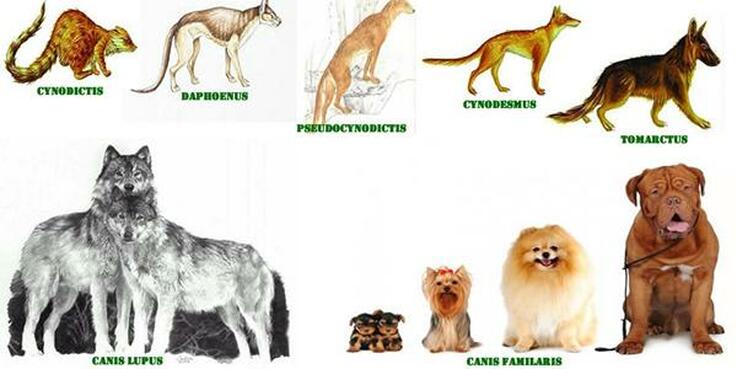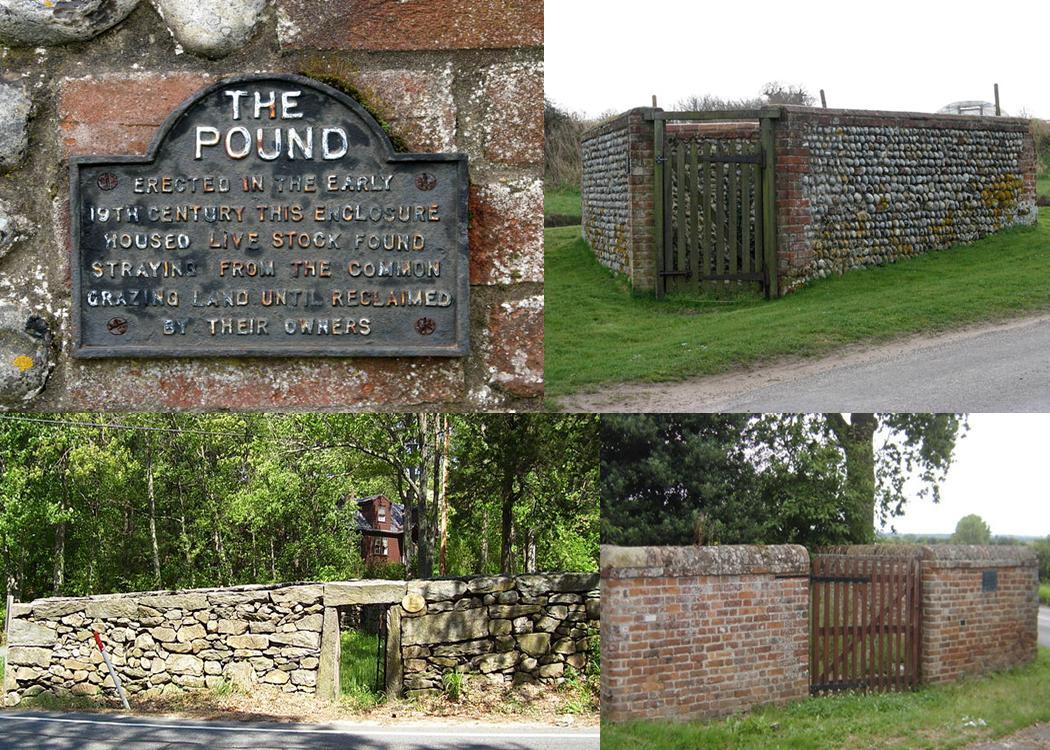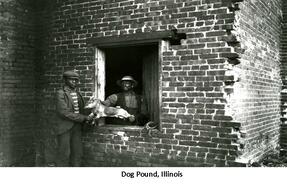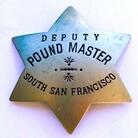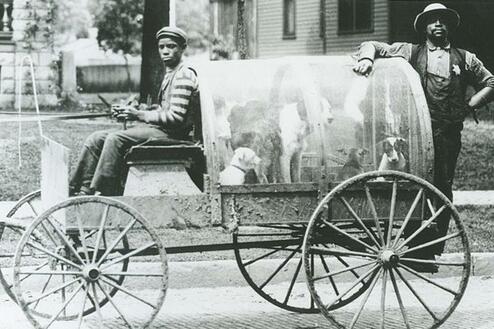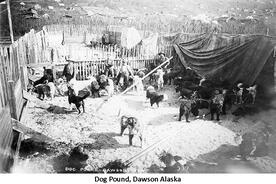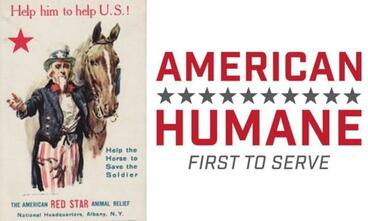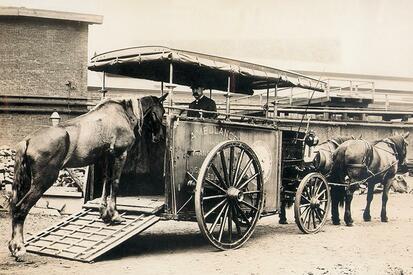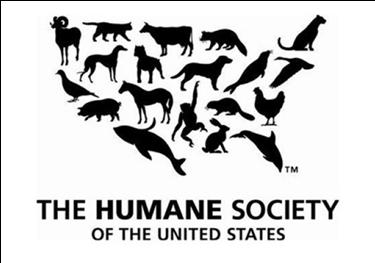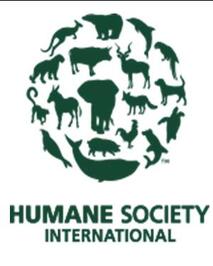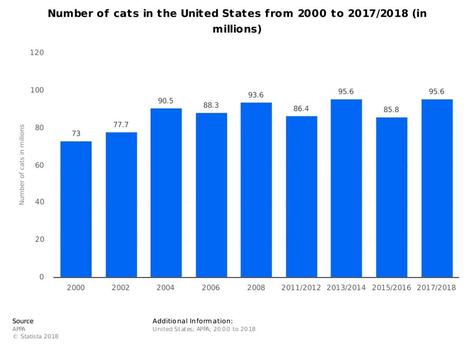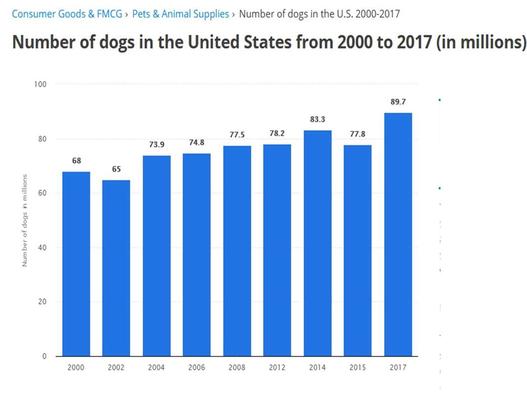A Collective Short History with Animals
Our early history with animals, notably the wolf and chicken, dates back 10,000 to 20,000 years ago. Wolf and man shared a similar social structure, hunted the same prey and both species gained a benefit from the other. As a result an ancient compact was formed and our relationship continues to this day. As man evolved, we brought certain animals along and diverted many of those animals’ natural breeding selections to satisfy our own desires.
In prehistoric times some wolves, goats, birds or other animals may have presented a shorter coat, larger or smaller teeth, brighter colors or a better ability to find prey. These desirable animals, whatever their attraction, shared food, shelter and safety with man. As these animals reproduced changes were affected in those species. Evidence of domestic dogs living among men have been found in Iraq and date as far back as 12,000 years.
Selective breeding of animals for certain characteristics was set in motion and continues to intensify. The strength of the ox was used to haul and pull for agriculture, cows used for labor, meat, hide, meat and draft animals followed soon after. Bloodlines were established. The domestic dog is now classified into breed groups. The American Kennel Club (AKC) recognizes 7 breed groups; the United Kennel Club (UKC) recognizes 8 breed groups. Understanding breed groups will significantly assist you in identifying, handling and predicting behaviors of dogs.
Today most domestic animals have little resemblance to their ancestors; however, the cat has retained much of their ancestry. Cats have the ability to live and prosper alongside man without much intervention. Along with their ability to rapidly reproduce makes the cat unique among domestic animals.
All horses as we know them today are the result of domestication and selective breeding. The only truly wild horse,
Przewalski’s horse, first discovered in Mongolia is now only found in zoos. North Carolina's "wild" horses are feral domesticated horses.
The use of animals markedly changed man’s own evolution. They provided food, clothing and protection, the ability to transport ourselves further and faster to other places and as a result, diversified our own gene pools.
Our early history with animals, notably the wolf and chicken, dates back 10,000 to 20,000 years ago. Wolf and man shared a similar social structure, hunted the same prey and both species gained a benefit from the other. As a result an ancient compact was formed and our relationship continues to this day. As man evolved, we brought certain animals along and diverted many of those animals’ natural breeding selections to satisfy our own desires.
In prehistoric times some wolves, goats, birds or other animals may have presented a shorter coat, larger or smaller teeth, brighter colors or a better ability to find prey. These desirable animals, whatever their attraction, shared food, shelter and safety with man. As these animals reproduced changes were affected in those species. Evidence of domestic dogs living among men have been found in Iraq and date as far back as 12,000 years.
Selective breeding of animals for certain characteristics was set in motion and continues to intensify. The strength of the ox was used to haul and pull for agriculture, cows used for labor, meat, hide, meat and draft animals followed soon after. Bloodlines were established. The domestic dog is now classified into breed groups. The American Kennel Club (AKC) recognizes 7 breed groups; the United Kennel Club (UKC) recognizes 8 breed groups. Understanding breed groups will significantly assist you in identifying, handling and predicting behaviors of dogs.
Today most domestic animals have little resemblance to their ancestors; however, the cat has retained much of their ancestry. Cats have the ability to live and prosper alongside man without much intervention. Along with their ability to rapidly reproduce makes the cat unique among domestic animals.
All horses as we know them today are the result of domestication and selective breeding. The only truly wild horse,
Przewalski’s horse, first discovered in Mongolia is now only found in zoos. North Carolina's "wild" horses are feral domesticated horses.
The use of animals markedly changed man’s own evolution. They provided food, clothing and protection, the ability to transport ourselves further and faster to other places and as a result, diversified our own gene pools.
The Pound
As the country settled the use of horses, cattle, sheep and other livestock were vital to survival and coveted assets. Common grazing areas were shared; fencing and other barriers were few. When livestock and other animals strayed into towns or fields under cultivation or other areas where they were not welcomed, they were confined in the village pound as they were in England. A Pound Master kept these animals until the owner came to claim them and pay for their care. Pounds were built in well organized villages and towns and as the American colonies grew, many pounds were built along with them. Today the "village pound" is generally known as an animal shelter.
A few pounds have survived and are preserved as historical sites. Plymouth, Massachusetts preserved their pound, built in 1671. The specifications for the pound were that it be "horse high, bull strong, and hog tight." The town voted to erect it and paid 8 pounds ($10.67 in dollars today) for its construction. The few pounds that are left are catalogued in the National Register of Historic Places.
As the country settled the use of horses, cattle, sheep and other livestock were vital to survival and coveted assets. Common grazing areas were shared; fencing and other barriers were few. When livestock and other animals strayed into towns or fields under cultivation or other areas where they were not welcomed, they were confined in the village pound as they were in England. A Pound Master kept these animals until the owner came to claim them and pay for their care. Pounds were built in well organized villages and towns and as the American colonies grew, many pounds were built along with them. Today the "village pound" is generally known as an animal shelter.
A few pounds have survived and are preserved as historical sites. Plymouth, Massachusetts preserved their pound, built in 1671. The specifications for the pound were that it be "horse high, bull strong, and hog tight." The town voted to erect it and paid 8 pounds ($10.67 in dollars today) for its construction. The few pounds that are left are catalogued in the National Register of Historic Places.
As villages grew into towns and cities the livestock pound evolved to include dogs. The Pound Master began working alongside the Dogcatcher to confine errant and destructive dogs and in an attempt to control rabies. In 1908 North Carolina recorded 20 dogs positive for rabies. That number grew to 899 rabid dogs in 1939. During this time 8 people died of rabies infection.
North Carolina enacted law in 1951 that allowed counties to employ Animal Control officers and Dog Wardens to protect livestock and citizens from dogs and to work as an assistant to the Rabies Control officer if one was present in that county. Rabies Control officers worked within or for Health Departments. Not long ago North Carolina's health directors "rode district" covering many counties. Most counties today employ a staff health director to oversee the health needs of their county. The Health Director is responsible for the control of rabies. Today, many animal officers act as a rabies control officer but many jurisdictions still employ a specific person or agency to act as rabies control officer. Rabies control remains a high priority for health departments and animal services. Animal officers must gain a good working knowledge of the virus, how it is transmitted and control methods.
We will discuss Rabies Control in Section 10.
North Carolina enacted law in 1951 that allowed counties to employ Animal Control officers and Dog Wardens to protect livestock and citizens from dogs and to work as an assistant to the Rabies Control officer if one was present in that county. Rabies Control officers worked within or for Health Departments. Not long ago North Carolina's health directors "rode district" covering many counties. Most counties today employ a staff health director to oversee the health needs of their county. The Health Director is responsible for the control of rabies. Today, many animal officers act as a rabies control officer but many jurisdictions still employ a specific person or agency to act as rabies control officer. Rabies control remains a high priority for health departments and animal services. Animal officers must gain a good working knowledge of the virus, how it is transmitted and control methods.
We will discuss Rabies Control in Section 10.
Livestock and pounds were commonplace in growing villages.
In 1973, North Carolina enacted law allowing counties and cities to use tax funds for animal control and protection programs, to prevent animal cruelty and the option to build an animal shelter. Many do not realize shelter facilities are an option. Today few North Carolina counties are without an animal shelter
In 1973, North Carolina enacted law allowing counties and cities to use tax funds for animal control and protection programs, to prevent animal cruelty and the option to build an animal shelter. Many do not realize shelter facilities are an option. Today few North Carolina counties are without an animal shelter
Animal use grew in size along with the country. Swift moving industrialization depended, to a large extent, on the horse who became victims of overwork and misuse. In 1880 New York removed 15,000 dead horses from its streets and horse manure became a public health crisis. Sweatshops also came into existence along with their well known child exploitation practices.
During the 19th century animal and child welfare advocates began voicing their concerns regarding child and animal abuse. In 1864 Henry Bergh an American diplomat, founded the ASPCA, the American Society for the Prevention of Cruelty to Animals. The ASPCA is America’s oldest animal welfare society. The ASPCA has a rich history in work to prevent cruelty to animals and children and continues this work to this day.
The ASPCA, based in New York maintains an Animal Poison Control Center, Recovery and Behavioral Centers and the Humane Alliance, now the Spay/Neuter Alliance, a teaching facility in the Asheville area of North Carolina providing low cost spay neuter services. The ASPCA also makes excellent training courses available in North Carolina and offers several other resources at ASPCA Pro online.
In 1877 the American Humane Association was founded, comprised of 27 organizations from 10 states. This collaboration was the first of its kind. The organization formed the "No Animals Were Harmed" Hollywood production certification program, provides service dogs to military veterans and provides grants for various incentives and procedures for operating an animal shelter.
In 1954 the Humane Society of the United States (HSUS) was founded and today is the nation's largest humane society. The HSUS provides training, assistance with large seizures, procedures for operating animal shelters, disaster rescue assistance and various other animal welfare programs. The HSUS also has an international division, Humane Society International.
The HSUS and AHA are recognized in North Carolina law regarding euthanasia (19A-32.1) in animal shelters and their shelter operational procedures are used across the state.
It is well worth the time to learn more about these organizations to learn how they can assist animal officers in North Carolina.
During the 19th century animal and child welfare advocates began voicing their concerns regarding child and animal abuse. In 1864 Henry Bergh an American diplomat, founded the ASPCA, the American Society for the Prevention of Cruelty to Animals. The ASPCA is America’s oldest animal welfare society. The ASPCA has a rich history in work to prevent cruelty to animals and children and continues this work to this day.
The ASPCA, based in New York maintains an Animal Poison Control Center, Recovery and Behavioral Centers and the Humane Alliance, now the Spay/Neuter Alliance, a teaching facility in the Asheville area of North Carolina providing low cost spay neuter services. The ASPCA also makes excellent training courses available in North Carolina and offers several other resources at ASPCA Pro online.
In 1877 the American Humane Association was founded, comprised of 27 organizations from 10 states. This collaboration was the first of its kind. The organization formed the "No Animals Were Harmed" Hollywood production certification program, provides service dogs to military veterans and provides grants for various incentives and procedures for operating an animal shelter.
In 1954 the Humane Society of the United States (HSUS) was founded and today is the nation's largest humane society. The HSUS provides training, assistance with large seizures, procedures for operating animal shelters, disaster rescue assistance and various other animal welfare programs. The HSUS also has an international division, Humane Society International.
The HSUS and AHA are recognized in North Carolina law regarding euthanasia (19A-32.1) in animal shelters and their shelter operational procedures are used across the state.
It is well worth the time to learn more about these organizations to learn how they can assist animal officers in North Carolina.
1864, First ASPCA ambulance
.
Fence & Stock Law go into Livestock Section
As the human population and agricultural use of land grew in North Carolina, so did livestock numbers. For centuries, farmers fenced their fields to protect crops from roaming livestock and other invaders. This practice was followed in North Carolina until 1873 when Alamance, Cabarrus, Mecklenburg, Orange, and Person Counties enacted a "no fence", or "fence out" law. Owners were required to "fence in" livestock in these counties. By 1880 many other counties followed suit and by 1917 it was effective throughout most of the state. North Carolina’s Livestock and Fence Law comprises the most antique law animal officers will likely encounter.
As the human population and agricultural use of land grew in North Carolina, so did livestock numbers. For centuries, farmers fenced their fields to protect crops from roaming livestock and other invaders. This practice was followed in North Carolina until 1873 when Alamance, Cabarrus, Mecklenburg, Orange, and Person Counties enacted a "no fence", or "fence out" law. Owners were required to "fence in" livestock in these counties. By 1880 many other counties followed suit and by 1917 it was effective throughout most of the state. North Carolina’s Livestock and Fence Law comprises the most antique law animal officers will likely encounter.
In 1983 the NC legislature enacted a law, since repealed (deleted); “Pound; disposition of impounded dogs.” for counties who employed a dog warden to erect a dog pound and hold dogs for a minimum of 72 hours. The Dog Warden kept records of the dogs, their length of stay, to whom the dog was released, collected fees and taxes and put dogs to death. The pound notified people bringing dogs to the facility that the animal may be destroyed, a practice that continues today. The Dog Warden collected the dog tax; many still do. The dog tax, while still present, may be designated as a privilege tax or fee.
This law also established the “72 hour” or “3 day rule”, a minimum holding period for dogs and cats held in animal shelters in North Carolina. This rule is still in effect today and found in §130A-192 and §19A‑32.1. We will explore these statutes in Section 10 Rabies Control and Section 12 Animal Welfare Act.
North Carolina also enacted several laws in 1983 mandating rabies inoculations for dogs and cats, established rabies vaccinators, rabies tags and control of vicious animals.
The Animal Shelter
From 2000 to 2017 households nationwide owning dogs increased from 68 million dogs owned to close to 90 million dogs. Cat ownership increased proportionately the same. Dogs and cats considered once only valuable for work or nuisances became family members and public awareness to animal welfare issues is now main stream. The pound master and the dog pound have given way to the animal control officer and to the animal shelter.
Increasing dog and cat ownership, under funding and the lack of easily accessible population control measures is resulting in a dog and cat population overwhelming animal shelters in North Carolina and many other states.
North Carolina reported receiving over 280,000 animals in 80 facilities in 2001 and the euthanasia of these animals ran into high numbers; as many as 95% of dogs and cats entering some shelters were destroyed. Overall, the state averaged destroying 60-65% of all animals admitted to animal shelters for many years.
Intake, adoption and euthanasia rates for licensed animal shelters are available online and are regularly viewed by the general public.
Montgomery County made headlines in 2012 when it was reported that 99% of the animals received were destroyed.
This law also established the “72 hour” or “3 day rule”, a minimum holding period for dogs and cats held in animal shelters in North Carolina. This rule is still in effect today and found in §130A-192 and §19A‑32.1. We will explore these statutes in Section 10 Rabies Control and Section 12 Animal Welfare Act.
North Carolina also enacted several laws in 1983 mandating rabies inoculations for dogs and cats, established rabies vaccinators, rabies tags and control of vicious animals.
The Animal Shelter
From 2000 to 2017 households nationwide owning dogs increased from 68 million dogs owned to close to 90 million dogs. Cat ownership increased proportionately the same. Dogs and cats considered once only valuable for work or nuisances became family members and public awareness to animal welfare issues is now main stream. The pound master and the dog pound have given way to the animal control officer and to the animal shelter.
Increasing dog and cat ownership, under funding and the lack of easily accessible population control measures is resulting in a dog and cat population overwhelming animal shelters in North Carolina and many other states.
North Carolina reported receiving over 280,000 animals in 80 facilities in 2001 and the euthanasia of these animals ran into high numbers; as many as 95% of dogs and cats entering some shelters were destroyed. Overall, the state averaged destroying 60-65% of all animals admitted to animal shelters for many years.
Intake, adoption and euthanasia rates for licensed animal shelters are available online and are regularly viewed by the general public.
Montgomery County made headlines in 2012 when it was reported that 99% of the animals received were destroyed.
Laws and Regulations
Municipal, or government operated, animal shelters are not regulated by Federal law nor are North Carolina’s governments required to construct or maintain an animal shelter. North Carolina gives local governments the option to construct an animal shelter but it is not required.
The United States enacted the Animal Welfare Act in 1966 to regulate the care of animals used in research. North Carolina followed in 1977 by enacting the NC Animal Welfare Act regulating the care of dogs and cats in commerce such as pet shops, boarding kennels and animal dealers but did not regulate governmental animal pounds or shelters until 2005.
It is important you gain a working knowledge of the NC Animal Welfare Act whether or not you work in an animal shelter.
We will discuss the Animal Welfare Act in Section 12.
Many organizations with concerns regarding North Carolina’s animal laws, including animal service organizations who routinely lobby at the local and state level to enact changes. Your knowledge, experience and voice will be important as North Carolina goes forward.
Municipal, or government operated, animal shelters are not regulated by Federal law nor are North Carolina’s governments required to construct or maintain an animal shelter. North Carolina gives local governments the option to construct an animal shelter but it is not required.
The United States enacted the Animal Welfare Act in 1966 to regulate the care of animals used in research. North Carolina followed in 1977 by enacting the NC Animal Welfare Act regulating the care of dogs and cats in commerce such as pet shops, boarding kennels and animal dealers but did not regulate governmental animal pounds or shelters until 2005.
It is important you gain a working knowledge of the NC Animal Welfare Act whether or not you work in an animal shelter.
We will discuss the Animal Welfare Act in Section 12.
Many organizations with concerns regarding North Carolina’s animal laws, including animal service organizations who routinely lobby at the local and state level to enact changes. Your knowledge, experience and voice will be important as North Carolina goes forward.
Animal control and animal welfare in North Carolina has had a stormy past. North Carolina is known as one of the slower moving states in improving our animal welfare and animal owner responsibility laws.
At the local level, individuals, organizations and many times, local officials generally do not, or will not, understand the complexity, limitations and responsibilities you have in protecting both people and animals and the compromises that must be made in serving an entire community of people and animals on demand.
North Carolina has not set standards for animal control officers or for their training, which is many times, on the job and covers a wide range quickly and under stressful circumstances. We all learn by our mistakes and this course is designed to make your mistakes minimal by offering an uncomplicated, basic overview of animal laws, regulations, resources and to share with you the experience of seasoned animal control professionals.
We have undertaken a very brief overview of the history and the beginnings of animal control. In this profession, every day will present a unique situation and even after many years on the job there is always more to learn!
North Carolina Laws is dedicated to supporting the active, professional animal officer.
At the local level, individuals, organizations and many times, local officials generally do not, or will not, understand the complexity, limitations and responsibilities you have in protecting both people and animals and the compromises that must be made in serving an entire community of people and animals on demand.
North Carolina has not set standards for animal control officers or for their training, which is many times, on the job and covers a wide range quickly and under stressful circumstances. We all learn by our mistakes and this course is designed to make your mistakes minimal by offering an uncomplicated, basic overview of animal laws, regulations, resources and to share with you the experience of seasoned animal control professionals.
We have undertaken a very brief overview of the history and the beginnings of animal control. In this profession, every day will present a unique situation and even after many years on the job there is always more to learn!
North Carolina Laws is dedicated to supporting the active, professional animal officer.
Questions?
Use your member name for questions, assistance or comments, we have your email address!
Use your member name for questions, assistance or comments, we have your email address!
North - South Carolina Laws - Animal Control - Animal Protection
PO Box 3341 Eden, NC 27289
